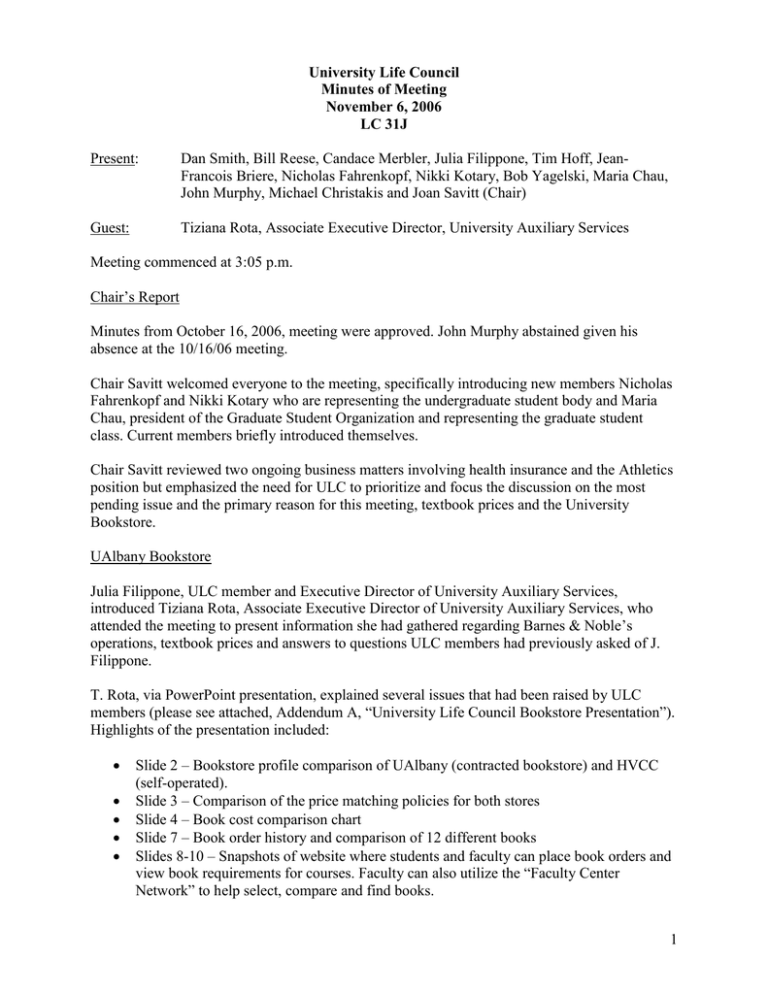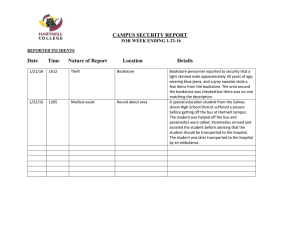November 6, 2006: Minutes
advertisement

University Life Council Minutes of Meeting November 6, 2006 LC 31J Present: Dan Smith, Bill Reese, Candace Merbler, Julia Filippone, Tim Hoff, JeanFrancois Briere, Nicholas Fahrenkopf, Nikki Kotary, Bob Yagelski, Maria Chau, John Murphy, Michael Christakis and Joan Savitt (Chair) Guest: Tiziana Rota, Associate Executive Director, University Auxiliary Services Meeting commenced at 3:05 p.m. Chair’s Report Minutes from October 16, 2006, meeting were approved. John Murphy abstained given his absence at the 10/16/06 meeting. Chair Savitt welcomed everyone to the meeting, specifically introducing new members Nicholas Fahrenkopf and Nikki Kotary who are representing the undergraduate student body and Maria Chau, president of the Graduate Student Organization and representing the graduate student class. Current members briefly introduced themselves. Chair Savitt reviewed two ongoing business matters involving health insurance and the Athletics position but emphasized the need for ULC to prioritize and focus the discussion on the most pending issue and the primary reason for this meeting, textbook prices and the University Bookstore. UAlbany Bookstore Julia Filippone, ULC member and Executive Director of University Auxiliary Services, introduced Tiziana Rota, Associate Executive Director of University Auxiliary Services, who attended the meeting to present information she had gathered regarding Barnes & Noble’s operations, textbook prices and answers to questions ULC members had previously asked of J. Filippone. T. Rota, via PowerPoint presentation, explained several issues that had been raised by ULC members (please see attached, Addendum A, “University Life Council Bookstore Presentation”). Highlights of the presentation included: Slide 2 – Bookstore profile comparison of UAlbany (contracted bookstore) and HVCC (self-operated). Slide 3 – Comparison of the price matching policies for both stores Slide 4 – Book cost comparison chart Slide 7 – Book order history and comparison of 12 different books Slides 8-10 – Snapshots of website where students and faculty can place book orders and view book requirements for courses. Faculty can also utilize the “Faculty Center Network” to help select, compare and find books. 1 Members noted in slide 2 that the “percent of orders received at deadline for UAlbany” was 12 percent whereas HVCC’s number was 75-80 percent. T. Rota explained that this large discrepancy had to do with the fact that HVCC tends to place orders for whole departments. It was also noted that UAlbany has 8 full time Bookstore staff and HVCC has 6 full time employees, even though HVCC, overall, is a smaller institution in terms of enrollment and course offerings. Members agreed it may be beneficial to try to increase bookstore staff to accommodate UAlbany’s needs. T. Rota explained UAlbany’s price matching policy and emphasized that UAlbany matches new and used book prices as long as the store is a bricks and mortar outlet. She explained slide 4, “book title cost comparison chart”, which outlined the cost for both a new and used copy of 14 different books and bundles. T. Rota highlighted the best price for each of the books and noted that if an individual shopped around at UAlbany, amazon.com and HVCC and bought the books for the least expensive price, the amount of money saved would be approximately $92.00. T. Rota stated that she attempted to obtain prices and copies of these 14 books from Mary Jane Books but they were not cooperative so there is no price comparison with Mary Jane. Jean-Francois Briere expressed concern that there is no incentive, or “disincentive”, for faculty to place their orders by the date requested. J. Filippone said that the motivation is that by placing an order early, it will help keep the prices down for students. Members agreed that faculty need to understand that ordering early can help keep prices down for students. Also discussed were concerns with the Bookstore “buyback” program. It was explained that placing an order early allows for more books to be bought back from Albany and non-UA sources which puts more used books on the shelves for the following semester. Robert Yagelski asked about buybacks for books that are used only once a year. Julia Filippone explained that obviously a book that may only be used once a year does not “count” for the next semester in the buyback process but that they are working with Barnes and Noble to help them understand the concept with classes that are offered on an academic year basis. Members discussed the problems they have experienced with book orders being placed in March but still not being available by the start of the Fall semester. Tiziana Rota explained that Barnes and Noble had operated on a “sourcing” policy for ordering books. Barnes and Noble goes to their primary source of books first and waits for a response. However, this used to mean that they would not be looking for a secondary source until they first source had said they did not carry the book. However, as a result of the ULC’s concerns, Tiziana has gotten that policy changed and now Barnes and Noble will source out sooner for foreign books. Tim Hoff asked if ordering books early will result in more used books being available for student purchase. J. Filippone explained that it can result in more books being bought back and thus more would be available. T. Hoff and Candace Merbler inquired about the corporate policy for mark-ups and noted that the mark-ups on new and used books is 25 percent. Tiziana Rota explained that she was still trying to fully understand the policy. Members agreed that what needs to be determined is if students should sell back their books to the Bookstore or seek other options. 2 R. Yagelski asked how a book buyback would be affected if the book was not being used the following semester. J. Filippone said that the Bookstore will buy it back but for less money (at 25% vs. 50% of the original price). Members noted that in this case, it would make sense for students to sell back that book to other campuses or through other retail outlets to get more money. Nikki Kotary provided student input regarding this topic. She stated that she sells back her books online or to another student. It can be worth the “hassle” to ship a book because you can get more money back. In the past, she has made a profit of as much as $35.00. C. Merbler asked how the Bookstore can know how many books they will actually have in stock for the following semester as most students will not be returning books until after exams. Tiziana Rota and other members noted that book buy back goes on all year and that the amount of money a student gets back simply depends on if the class is happening next semester and as a result could be the difference between receiving 25 percent versus 50 percent of the value for a book. Members asked the undergraduate student representatives if there are any problems with ensuring that they received the money they are owed for books that are sold online. N. Kotary explained that the entire process is very simple and that there are generally measures in place for ensuring you receive your money and in most instances even if something happens, you will still get the money you are owed. R. Yagelski proposed a situation in which a student could receive $65 for a book by selling it online versus $50 that the Bookstore may be offering and if the process would still be worth it for the $10 a student might make. Nicholas Fahrenkopf said that it depends on the situation and that he has books for sale online that still haven’t sold. Tim Hoff asked if Barnes and Noble might be willing to consider a more generous buyback policy and in particular for courses offered once an academic year. J. Filippone asked about selling old editions and if that might help the situation. N. Fahrenkopf said that he has taken several courses that are offered once a year and he holds on to the book and sells it back the following semester. Members discussed how the Bookstore could be alerted to books that are used for the once-ayear courses so they could buy back the books and not make students wait a semester to sell them. D. Smith stated that the Registrar could indicate in the bulletin if a course is offered once a year. T. Hoff was concerned that this situation could restrict professors (in terms of book choices) but wanted to still find a way to allow the Bookstore to buy back the books. T. Rota explained the comparison slide of the ordering history for 12 books including the order date, enrollment in the course, the number of buybacks available and how many books were eventually sold. In one instance, the used book sales for a widely-used business law course resulted in total savings for students of more than $27,000 over the regular retail price. Members discussed the ability of students to access their book requirements online and T. Rota reviewed the slides which showed snapshots of the active website where students and staff can visit to place orders and review course requirements. Professors have access to their own website where they can do research and compare different books to decide on what they would like to use for their courses. 3 Members discussed questions and concerns regarding commissions and where the money goes. Tiziana Rota and Julia Filippone explained that money goes towards UAS overhead, services and the programs that UAS funds and emphasized that the commission money comes in from all the vendors that UAS has contracts with, not just the Bookstore. Chair Savitt and members thanked Tiziana and Julia for their presentation and all members agreed that it was very informative. J. Filippone will get answers to some questions that were asked regarding mark-ups and used books. Acquaintance Rape Task Force Chair Savitt is serving on the Acquaintance Rape Task Force, a group which has been tasked with issuing a report and recommendations by the end of this year. Chair Savitt asked what the ULC wanted to do in regards to moving forward with supporting the committee and next steps. Members discussed the direct charge from Officer-In-Charge Susan Herbst which covers several points including assessing the current situation, soliciting feedback and making recommendations. Members felt it seemed to make sense to wait until the recommendations come back from the Task Force to best see what the ULC can do to support and follow through on them. Maria Chau, Graduate Student Organization president, stated that GSO is working with the administration regarding the overall University environment and safety and security issues that should be improved upon. M. Chau is particularly concerned about lighting problems and C. Merbler agreed that wattage is a problem with some of the lighting. Nikki Kotary, undergraduate student representative, expressed concerns as well and stated that she felt that there should always be notification of sexual assaults. Maria encouraged members to attend a forum on some of these issues hosted by GSO on Monday, November 13 at 5:15 p.m. Tim Hoff hoped that it would be possible to somehow express to the Executive Committee that the ULC should review the final report as soon as it is completed so that the council could make recommendations on items identified in the report as needing action. Dan Smith made a motion supporting this, C. Merbler seconded the motion and it was unanimously passed. Chair Savitt will hold off on forming subcommittees until the Task Force comes back with recommendations, except for the Athletics Committee which is active. Dan Smith, chair of the subcommittee, reviewed the minutes from the last Athletics Subcommittee meeting held on November 3, 2006 (please see attached, Addendum B, “Athletics and Recreation Committee Meeting”). Next meeting is November 20, 2006 at 3:00. Meeting was adjourned at 4:30 p.m. Respectfully Submitted, Nancy Lauricella, Recording Secretary 4
